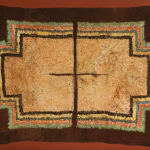Nazca Culture 100 BC-800 AD
Complete Feather Tunic, Circa. 200 AD
Camelid fibres with applied feathers.
132 x 177 cm
51,9 x 69,6 in
51,9 x 69,6 in
NAZ0046
Copyright of Paul Hughes Fine Arts
Of universal appeal and unique beauty, feathers have for thousands of years been used by people in all parts of the Andeas to adorn themselves and to animate their environment....
Of universal appeal and unique beauty, feathers have for thousands of years been used by people in all parts of the Andeas to adorn themselves and to animate their environment. Among traditional societies, garments and other objects embellished with feathers also have great cultural value and are imbued with spiritual energy and supernatural force.
From an aesthetic point of view, Andean feathers works speak more eloquently for themselves than a thousand words. It should, however, be pointed out that their sacredness was not a function of their rarity but rather, by association with the Celestial messenger, the Condor —Eagle, the wearer shared the supernatural powers of this divine intercessor, guide of the souls to the mystical realm of light.
From an aesthetic point of view, Andean feathers works speak more eloquently for themselves than a thousand words. It should, however, be pointed out that their sacredness was not a function of their rarity but rather, by association with the Celestial messenger, the Condor —Eagle, the wearer shared the supernatural powers of this divine intercessor, guide of the souls to the mystical realm of light.
Publications
Confluences in Art: from the old and new worlds,Paul Hughes Fine Art, p.82-8322
of
22



